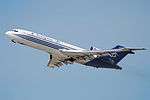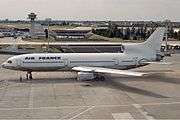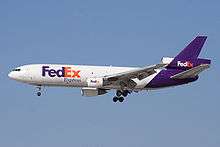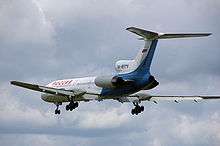Trijet
A trijet is a jet aircraft powered by three jet engines. In general, passenger airline trijets are considered to be second-generation jet airliners, due to their innovative engine locations, in addition to the advancement of turbofan technology.

.jpg)
Other variations of three-engine designs are trimotors, which are aircraft with three propellers (driven by piston engines or turboprops).
Design


One issue with trijets is positioning the central engine. This is mostly accomplished by placing the engine along the centerline, but this still poses difficulties.
The most common configuration is having the central engine located in the rear fuselage and supplied with air by an S-shaped duct; this is used on the Hawker Siddeley Trident, Boeing 727, Tupolev Tu-154, Lockheed L-1011 TriStar, and, more recently, the Dassault Falcon 7X. The S-duct has low drag, and since the third engine is mounted closer to the centerline, the aircraft will normally be easy to handle in the event of an engine failure. However, S-duct designs are extremely complex and costly. Furthermore, the central engine bay would require structural changes in the event of a major re-engining. For example, the 727's central bay was only wide enough to fit a low-bypass turbofan and not the newer high-bypass turbofans which were quieter and more powerful. Boeing decided that a redesign was too expensive and ended its production instead of pursuing further development. The Lockheed Tristar's tail section was too short to fit an existing two-spool engine as it was designed only to accommodate the new three-spool Rolls-Royce RB211 engine, and delays in the RB211's development, in turn, pushed back the TriStar's entry into service which affected sales.[1]
The McDonnell Douglas DC-10 and related MD-11 use an alternative "straight-through" layout, which allows for easier engine installation, modification, and access. It also has the additional benefit of being much easier to re-engine. However, this sacrifices aerodynamics compared to the S-duct. Also, as the engine is located much higher up than the wing-mounted engines, engine failure will produce a greater pitching moment, making it more difficult to control.
The placement of the remaining two engines varies. Most smaller aircraft, like the Hawker Siddeley Trident, the Boeing 727 and the Tupolev Tu-154 have two side-mount engine pylons in a T-tail configuration. The larger widebody Lockheed TriStar and DC-10/MD-11 mount an engine underneath each wing. Preliminary studies were done on the TriStar to reuse the fuselage and wing for a twinjet design though these never materialized due to Lockheed's lack of funds. Additionally in the late-1990s Boeing, which had taken over McDonnell Douglas, considered removing the tail engine from the MD-11 to make it a twinjet but ending up instead ending its production altogether, as the 767 and 777 would have cannibalized it.[1]
Advantages and drawbacks
One major advantage of the trijet design is that the wings can be located further aft on the fuselage, compared to twinjets and quadjets with all wing-mounted engines, allowing main cabin exit and entry doors to be more centrally located for quicker boarding and deplaning, ensuring shorter turnaround times. The rear-mounted engine and wings shift the aircraft's center of gravity rearwards, improving fuel efficiency, although this will also make the plane slightly less stable and more difficult to handle during takeoff and landing. (The McDonnell Douglas DC-9 twinjet and its derivatives, whose engines are mounted on pylons near the rear empennage, have similar advantages/disadvantages of the trijet design, such as the wings located further aft and a more rearward center of gravity.)
Trijets are more efficient and cheaper than four-engine aircraft, as the engines are the most expensive part of the plane and having more engines consumes more fuel, particularly if quadjets and trijets share engines of similar power, making the trijet configuration more suited to a mid-size airliner compared to larger quadjets. However, higher purchase prices, primarily due to the difficulty and complexity of mounting the third engine through the tail, will somewhat negate this advantage.
Due to their added thrust, trijets will have slightly improved takeoff performance compared to twinjets if an engine fails. Because takeoff performance for aircraft is usually calculated to include an extra margin to account for a possible engine failure, trijets are better able to take off from hot and high airports or those where terrain clearance near the runway is an issue.
Unlike twinjets, trijets are not required to land immediately at the nearest suitable airport if one engine fails (this advantage is also shared with quadjets).[2] This is advantageous if the aircraft is not near one of the operator's maintenance bases, as the pilots may then continue the flight and land at an airport where it is more suitable to perform repairs. Additionally, for trijets on the ground with one engine inoperative, approval can be granted to perform two-engine ferry flights. Prior to the introduction of ETOPS, only trijets and quadjets were able to perform long international flights over areas without any diversion airports. However, this advantage has largely disappeared in recent years as ETOPS-certified twin-engined aircraft are able to do so as well.
The biggest obstacle trijets face today is operating costs, primarily fuel efficiency, as a three-engine design almost certainly consumes more fuel than a comparable two-engine design. This also greatly increases the difficulty of marketing a new trijet aircraft today, especially for passenger service. However this was worth the trade-off between 1970 and the 1990s when trijets and twinjets shared engines of similar output, such as when the DC-10, MD-11, and Airbus's A300 and A330 were all powered by the General Electric CF6, and the additional power from the third engine gave the DC-10/MD-11 advantages in longer range and/or heavier payload over the A300/A330 twinjet. Since the 1990s, with further advancements in high-bypass turbofan technology, large twinjets have been equipped with purpose-designed engines like the Boeing 777's General Electric GE90, allowing twinjets to perform the same tasks as most trijets and even many quadjets but more efficiently.
History
.jpg)

.jpg)
The first trijet design to fly was the Tupolev Tu-73 bomber prototype, first flown in 1947.[3] The first commercial trijets were the Hawker Siddeley Trident (1962) and the Boeing 727 (1963). Both were compromises to meet airline requirements; in the case of the Trident, it was to meet BEA's changing needs, while the 727 had to be acceptable for three different airlines. Although collaboration between the manufacturers was considered, it did not come about.[4]
Early American twinjet designs were limited by the FAA's 60-minute rule, whereby the flight path of twin-engine jetliners was restricted to within 60 minutes' flying time from a suitable airport, in case of engine failure. In 1964, this rule was lifted for trijet designs, as they had a greater safety margin.
For second-generation jet airliners, with the innovations of the high-bypass turbofan for greater efficiency and reduced noise, and the wide-body (twin-aisle) for greater passenger/cargo capacity, the trijet design was seen as the optimal configuration for the medium wide-body jet airliner, sitting in terms of size, range, and cost between quadjets (four-engine aircraft) and twinjets, and this led to a flurry of trijet designs. The four-engine Boeing 747 was popular for transoceanic flights due to its long-range and large size, but it was expensive and not all routes were able to fill its seating capacity, while the original models of the Airbus A300 twinjet were limited to short- to medium-range distances. During this period, different jet airliners shared engines of similar output, such as when the McDonnell Douglas DC-10, Airbus A300, and Boeing 767 were powered by the General Electric CF6, the additional power from the third engine gave the DC-10 advantages in longer range and/or heavier payload over the A300 and 767 twinjets. Thus trijet designs such as the DC-10 and L-1011 TriStar represented the best compromise with medium- to long-range and medium size that US airlines sought for their domestic and transatlantic routes. As a result of these trijet wide-bodies, as well as the popularity of the Boeing 727, in their heyday of the 1980s trijets made up a majority of all such US jet airliners.
From 1985 to 2003 the number of such planes in service had sunk from 1488 to 602. The number of twinjets, on the other hand, had more than quadrupled in the same period.[5] Both Lockheed and McDonnell Douglas were financially weakened competing in the widebody market, which led to Lockheed ending production of the L-1011 in 1984 after producing only half the units needed to break even, while a number of fatal DC-10 crashes also slowed its sales.[1] In 1984 Boeing ended production of the 727, as its central engine bay would require an extremely expensive redesign to accommodate quieter high-bypass turbofans, and it was soon supplanted by Airbus with their A320 and Boeing with their 737 and 757. Further advancements in high-bypass turbofan technology and subsequent relaxation in airline safety rules made the trijet and even the quadjet nearly obsolete for passenger services, as their range and payload could be covered more efficiently with large twinjets powered with purpose-designed engines such as the 777's General Electric GE90.
During the 1980s, McDonnell Douglas was the only Western manufacturer to continue development of the trijet design with an update to the DC-10, the MD-11, which initially held a range and payload advantage over its closest medium wide-body competitors which were twinjets, the in-production Boeing 767 and upcoming Airbus A330. McDonnell Douglas had planned a new trijet called the MD-XX, which were lengthened versions of the MD-11. The MD-XX Long Range aircraft would have been capable of traveling distances up to 8,320 nautical miles (15,410 km) and had a wingspan of 65 metres (213 ft). The project was canceled in 1996, one year before McDonnell Douglas was acquired by Boeing. Boeing ended production of the MD-11 after filling remaining customer orders since the MD-11 would have competed with the 767 and 777. A study to remove the MD-11's tail-mounted engine (which would have made it a twinjet) never came to fruition as it would have been very expensive, and the MD-11 had very little in common in terms of design or type rating with other Boeing airliners.[6] In contrast to McDonnell Douglas sticking with their existing trijet configuration, Airbus (which never produced a trijet aircraft) and Boeing worked on new widebody twinjet designs that would become the A330 and 777, respectively. The MD-11's long-range advantage was brief as it soon was threatened by the A330's four-engine derivative, the A340, and the 777. The only other notable trijet development during the 1980s was in the Soviet Union, where the Tupolev Tu-154 was re-engined with the Soloviev D-30 engine as well as a new wing design and entered serial production from 1984 as the Tu-154M.
With the exception of the Dassault Falcon 7X, Falcon 8x, and Falcon 900, no manufacturer now produces three-engine airliners.
Current status
Modern engines have extremely low failure rates and can generate much higher shaft power and thrust than early types. This makes twinjets more suitable than they were before for long-haul trans-oceanic operations, resulting in eased ETOPS restrictions; modern wide-body twin-engine jets usually have an ETOPS 180 or even (in the case of the Boeing 777 and 787) ETOPS 330 rating. As such, having more than two engines is no longer considered necessary, except for very large or heavy aircraft such as the Boeing 747, Airbus A380 (over 400 seats in a mixed-class configuration), Antonov An-124, and An-225, or for flights through the Southern Hemisphere, primarily to and from Australia (which has not yet adopted the ETOPS 330 standard), where the most direct route for some flights is over Antarctica.[7]
Today, both narrow-body and wide-body trijet production has ceased for almost all commercial aircraft, being replaced by twinjets. As of 2016, the Falcon 7X, 8X, and 900 business jets, all of which use S-ducts, are the only trijets in production. Some old models, such as the 727, Tu-154, DC-10, and MD-11, have found second careers as cargo aircraft, as well as limited charter, governmental, and military service. The most widely used trijets are the DC-10 and the MD-11, mostly operated by UPS Airlines and FedEx Express in cargo service.
For private and corporate operators, where fuel efficiency is often less important than for airlines, trijets may still be of interest due to their immunity from ETOPS and the ability to take off from shorter runways. As a result, a sizeable number of trijets, such as 727s and newly built Dassault Falcons, are in use by private operators and corporate flight departments.
Future of trijets
Airbus filed a patent in 2008 for a new, twin-tail trijet design, whose tail engine appears to use a "straight" layout similar to the MD-11, but it is unknown when or if this will be developed or produced.[8] However, the proposed Boeing X-48 blended wing body design, Lockheed's N+2 design study, and Aerion AS2 supersonic business jet also have three engines.[9][10] The AS2 is currently taking orders and a wooden mockup has been constructed.[11][12]
Boom Technology's planned Overture supersonic transport (SST) airliner is planned to use three engines, with the third engine installed in the tail with a Y-shaped duct and air intakes on both sides of the rear.
Examples
Proposed or suspended trijet developments
- Boeing 747-300 Trijet – downsized 747 to compete with the DC-10 and L-1011, changed to four engines
- Blended Wing Body Trijet – proposed design based on the Boeing X-48
- McDonnell Douglas MD-XX – stretched derivative of the DC-10, project shelved
- North American NR-349 – proposed interceptor derivative of the A-5 Vigilante, cancelled
- Airbus twin-tail trijet,[8] – status unknown
- Dassault Supersonic Business Jet – suspended
- Aerion AS2[13]
- Sukhoi-Gulfstream S-21
- Boom Technology Overture
- Boeing 777 – Originally envisioned as a trijet 767 in the 1970s to compete with the DC-10 and the L-1011; later became a new twin-engine design.
See also
References
- "Requiem For a Trijet Masterpiece – The Lockheed L-1011". September 30, 2015.
- "14 CFR § 121.565 – Engine inoperative: Landing; reporting".
- Duffy, Paul; Kandalov, A. I. (1996). Tupolev: The Man and His Aircraft. ISBN 978-1-56091-899-8.
- "Commercial Jets". Modern Marvels. Season A149. January 16, 2001. approx. 15 minutes in.
- Table 1-13: Active U.S. Air Carrier and General Aviation Fleet by Type of Aircraft Bureau of Transportation Statistics
- "News Channel | Homepage".
- Irving, Clive (2014-01-06). "Most International Flights Will Soon Have Two Fewer Engines…But That's OK". The Daily Beast.
- Airbus files patent for new trijet design, FlightGlobal.com, Retrieved 2008-12-11.
- "Our Customer Focus, Innovation and Purpose Stories".
- "Aerion's AS2 supersonic business jet gets extra engine and cabin space". 2014-05-21.
- "Flexjet Boosts Supersonic Bizjet Plan with Aerion AS2 Order".
- "BlueSky Business Aviation News – blueskynews.aero".
- "Archived copy". Archived from the original on 2014-07-28. Retrieved 2014-07-20.CS1 maint: archived copy as title (link)
- Modern Commercial Aircraft Willian Green, Gordon Swanborough and John Mowinski, 1987